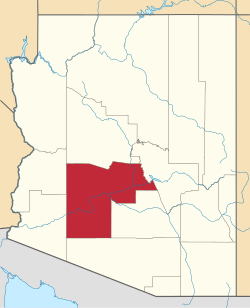Chandler, Arizona | |
|---|---|
City | |
 Aerial view of Chandler | |
 Location in Maricopa County, Arizona | |
| Coordinates: 33°18′N111°50′W / 33.300°N 111.833°W | |
| Country | United States |
| State | |
| County | Maricopa |
| Founded | May 17, 1912 |
| Government | |
| • Type | Council-Manager |
| • Mayor | Kevin Hartke [1] |
| Area | |
• City | 65.55 sq mi (169.77 km2) |
| • Land | 65.48 sq mi (169.58 km2) |
| • Water | 0.07 sq mi (0.18 km2) |
| Elevation | 1,211 ft (370 m) |
| Population (2020) [2] | |
• City | 275,987 |
| 280,711 | |
| • Rank | US: 79th |
| • Density | 4,226.4/sq mi (1,627.45/km2) |
| • Metro | 4,948,203 |
| • Demonym | Chandlerite |
| Time zone | UTC−7 (MST (no DST)) |
| ZIP Codes | 85224-85226, 85244, 85246, 85248-85249, 85286 |
| Area code | 480 |
| FIPS code | 04-12000 |
| GNIS feature ID | 2409433 [3] |
| Website | www |
Chandler is a city in Maricopa County, Arizona, United States, and a suburb in the Phoenix-Mesa-Chandler Metropolitan Statistical Area. It is the fourth-most populous city in Arizona, after Mesa, Tucson, and Phoenix. Chandler is considered to be a part of the East Valley.
Contents
- History
- Geography
- Climate
- Demographics
- 2020 census
- Economy
- Top employers
- Arts and culture
- Parks and recreation
- Government
- City government
- Federal representation
- State representation
- Education
- Elementary and secondary
- Post-secondary
- Infrastructure
- Transportation
- Notable people
- Sister cities
- See also
- References
- External links
As of the 2020 census, the population of Chandler was 275,987, [2] up from 236,123 at the 2010 census. [4] Chandler is a commercial and tech hub for corporations like Intel, Northrop Grumman, Wells Fargo, PayPal and Boeing.








